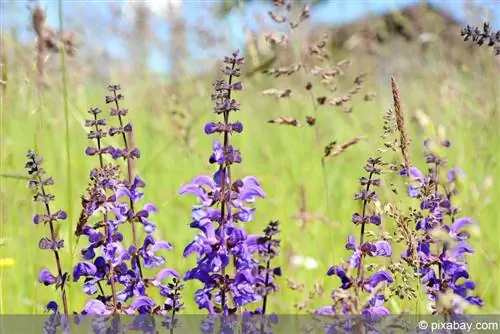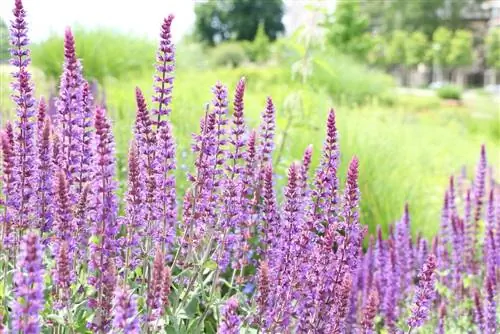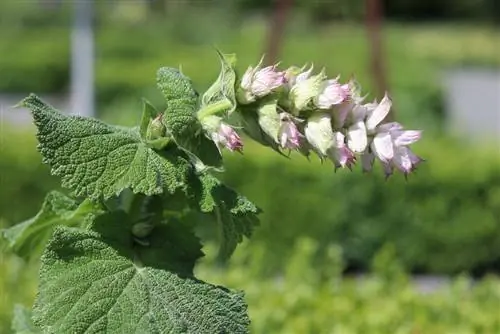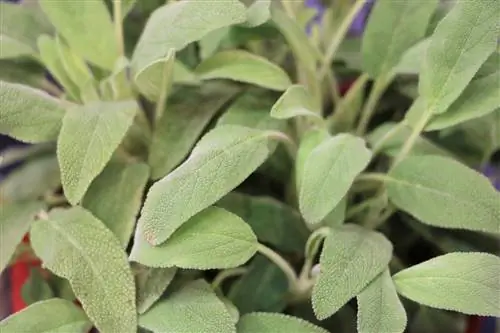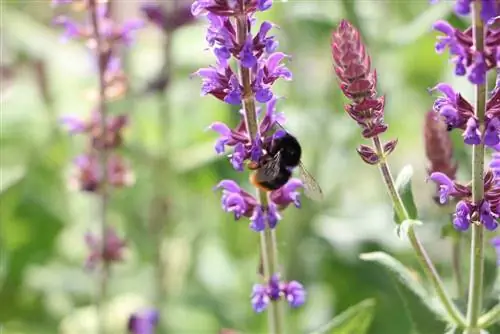- Author admin [email protected].
- Public 2023-12-17 03:39.
- Last modified 2025-01-24 12:45.
The meadow sage impressively demonstrates what multilateral plants Mother Nature can produce. As a wild form within the sage genus, the perennial subshrub in the cottage garden makes a lasting contribution to ecological balance as a bumblebee and butterfly pasture. Its valuable contribution to the herb garden as a spice and medicinal plant is in no way inferior. On top of that, the pretty blue flower candles in the pot serve as a decorative eye-catcher. Use the profile below to explore interesting attributes and benefit from the care tips.
Profile
- Plant family: Mint family (Lamiaceae)
- Genus: Sage (Salvia)
- Type: Meadow sage (Salvia pratensis)
- Native subshrub with blue flower candles
- Flowering period from May to August
- Split fruits in July and August
- Growth height up to 60 centimeters
- Hardy and perennial
- Typical propagation strategy using the sage lever mechanism
- Use: spice and medicinal plant, ornamental plant, bumblebee willow
Explanations to the profile
The profile reveals exciting properties that make me curious about the wide range of benefits of meadow sage. Since no breeder had any influence here, the wild form serves as a popular useful and ornamental plant within the sage genus, especially in natural gardens. In the kitchen, the housewife uses fresh meadow sage leaves to give fish and meat dishes, sauces, vegetables or pizza a Mediterranean touch. While real sage has a very intense taste, meadow sage scores with a much milder aroma. In the healing arts, the famous nun Hildegard von Bingen swore by the effectiveness of meadow sage for a wide variety of ailments as early as the Middle Ages. To this day, components of sage can be found in various medicines, for example to treat colds, inflammation of the throat or gums.
The functionality of the lever mechanism with which meadow sage is equipped for propagation is a source of astonished interest among hobby gardeners. The typical flowers have an upper and a lower lip. The stamens that carry the pollen are positioned below the upper lip. These are connected to a plate inside the flower that blocks the throat. Because a bumblebee wants to get there, it puts pressure on the plate. The curved anther arms then lower themselves onto the insect's fur like a lever and strip off the pollen. The bumblebee thus distributes the pollen when it visits other flowers. Interestingly, the flower is able to portion its pollen for up to twelve visiting bumblebees.
Care tips
Meadow sage migrated to the local regions from the Mediterranean region generations ago. In the wild, the plant mainly inhabits dry, sunny locations along arable groves up to the low mountain ranges. The central premises for successful care have already been defined. The following lines explain what this is about in detail.
Watering and fertilizing
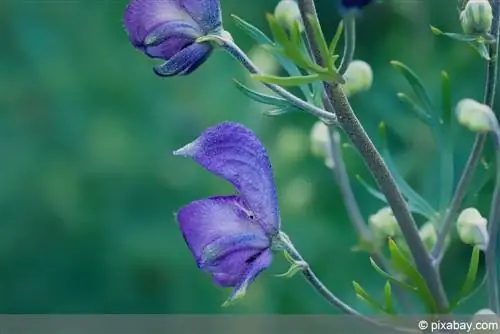
One of the many advantages of meadow sage is its undemanding nature. It doesn't take much fuss to provide the plant with an adequate water and nutrient balance:
- If it is dry, water after a thumb test
- As a container plant, water regularly, allowing the soil surface to dry out
- Administer a starting fertilizer made from compost or manure in the spring
- Administer an organic liquid fertilizer in the planter
During the growing season, the application of fertilizer continues every three to four weeks. The nutrient supply ends at the beginning of August so that meadow sage can prepare for the coming winter.
Tip:
The vitality of meadow sage is further strengthened by adding primary rock powder to the substrate once a month.
Cutting and harvesting
Meadow sage provides an aromatic harvest of rich leaves almost all year round. The shoot tips are preferred for use as a spice. Older leaves have a bitter taste. It is always harvested along with the stem, but cutting into the wood should be avoided. Meadow sage develops its optimum in its second year, shortly before flowering. This date is of particular interest to gardeners who want to stock up on dried sage leaves. Immediately after flowering, pruning by half is recommended to support growth for the next season. In early spring, cut the meadow sage back to a hand's width above the ground. If the plant is already more woody, the pruning ends at the upper end of the woodiness.
Propagate
If more specimens are desired, the propagation of meadow sage is pleasantly uncomplicated. The following two approaches are available.
Cuttings
During summer is the best time to propagate meadow sage from cuttings. To do this, choose a well-established and, above all, he althy plant. Here's how to do it:
- Cut off one or more shoots with a length of 15-20 centimeters
- Fill small pots with herb soil that has been thinned with a little sand
- Leave the lower half of a cutting, halve the leaves of the upper half
- Insert into the substrate, water and place in a warm, partially shaded place
During the following days and weeks, keep the potting soil constantly moist without causing waterlogging. Rooting is complete when the cuttings sprout again. The process is accelerated if each cultivation pot is given a small plastic hood that is ventilated regularly.
Sowing
Sowing seeds indoors is possible from February. Since these germinate in light, this form of propagation is also unproblematic.
- Fill a seed tray with peat sand, coconut fibers or sowing soil
- Spread the seeds and press them on
- Moisten with water from the spray bottle
- Cover with glass or cling film
On a bright, not full-sunny windowsill, germination begins within 14 days. During this time the substrate must not dry out. After the cotyledons have pushed out of the seeds, the cover can be dispensed with. The young plants are transplanted into individual pots if they have two pairs of real leaves.
Plants

The meadow sage grown in the house or purchased ready-made is planted outdoors from mid-May. To do this, choose a location in full sun, but not directly in front of a wall, where the heat accumulates in summer. The soil should be sandy-dry, nutrient-rich and humus. The wild plant feels particularly comfortable in a stone or gravel garden. Of central importance is the permeable nature of the soil, which is ideally calcareous. While the planting site is being prepared, soak the root ball of the young plant with water until no more air bubbles appear.
- Loosen and clean the soil
- Create small pits with twice the volume of the root ball
- A planting distance of 30 centimeters is considered suitable
- Enrich the excavation with a mixture of sand and compost
- Insert the potted meadow sage and water well
The freshly planted plant is then watered regularly until it has grown.
Tip:
A mulch layer of gravel or chippings effectively contributes to heat retention in the ground.
Wintering
Winter protection for meadow sage is recommended when young or in explicitly rough locations. In the bed, cover the plants with pine fronds, brushwood or straw. In the pot, the root ball in particular is at risk from frosty temperatures. To prevent it from freezing, place the planter on insulating wood and wrap it with fleece or foil. The substrate is protected by a layer of leaves or pine needles. If there is no snow in winter and it is freezing at the same time, water the meadow sage on a frost-free day.
Conclusion
Meadow sage has been known as a universal talent since ancient times. It not only adorned farm and monastery gardens, but also served as a versatile spice and medicinal plant. Its advantageous attributes are more relevant today than ever before, because with the wild form within the sage genus, a frugal and easy-care plant is finding its way into every green realm. As long as meadow sage is not exposed to permanent drought and receives a little compost every 4 weeks, it fulfills its diverse tasks with flying colors.

